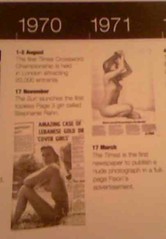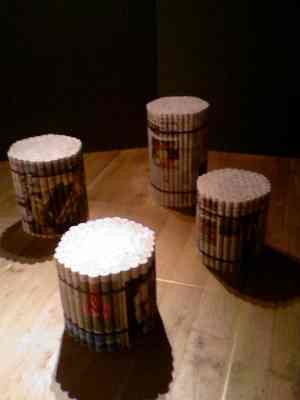When an artist is honoured with a retrospective by a major gallery, it tends to be taken as a sign of graceful retirement, so what does it mean that the British Library’s main exhibition space is now occupied by an exhibition titled “Front Page: Celebrating 100 Years of the British Newspaper”? With total circulation still going down, despite Britons still being among the most enthusiastic newspaper readers in the world, is this the final nostalgic bow of dead-tree newspapers before the power of the electronic age?
The division of visitors by age within the exhibition is not, perhaps, a good sign. Those aged under 30 were, when I visited, confined to the central part – the bank of computers at which they are invited to prepare their own front page. Older visitors were spread around the walls, checking out those familiar front pages, from Bobby Moore holding the World Cup aloft in 1966 toe Sun’s famous “turn out the lights” Kinnock front page from the 1992 election.
The spine of the exhibition is, as you would expect, a chronological account of newspaper firsts, from 1908 – Daily Mail has its first “Ideal Homes Exhibition” to 2004 – Suduko craze begins. A whole lot of flat, yellowing rectangles on the wall could be rather dull, but a lot of effort has gone into the texture of the exhibition – each 20 years or so being contained within a “room” themed for the period. So the Twenties-to-Forties is viewed from beneath a flimsy air-raid shelter, complete with “don’t forget your gas mask” stickers; the Nineties are seen from a Thatcherite loft apartment, complete with dodgy “designer” furniture.
Some aspects of the chronology are rather later than might have been expected: It was only on December 20 1912 that the national press agreed not to publish on Christmas Day. (Has the Competition Commission looked at this?) It was 1914 when the first half-tone photo appeared in The Times — of Velasquez’s Rokeby Venus damaged in the suffragette protest — and 1924 when the first crossword puzzle was printed, in the Sunday Express.
Some milestones are, however, earlier than you might expect. It was on
24 August 1930 that the first newspaper astrology column was printed, also in the Sunday Express, predicting the future of the newly born Princess Margaret. They don’t, however, tell you how accurate it proved. In 1934 the Daily Mail had the first radio-transmitted picture from Australia on its front page — surprise, surprise of a stereotypical Aboriginal. His body painted, he carries a boomerang and a didgeredoo.
 Stephanie Rahn. Beside it, from less than a year later, is a full-page advertisement from The Times described as “the first newspaper to publish a fully nude picture of a woman (carefully arranged of course). Imagine all of those retired colonels spluttering into their morning tea – but it shows how far back “The Thunderer’s” populist, tabloid tendencies extend.
Stephanie Rahn. Beside it, from less than a year later, is a full-page advertisement from The Times described as “the first newspaper to publish a fully nude picture of a woman (carefully arranged of course). Imagine all of those retired colonels spluttering into their morning tea – but it shows how far back “The Thunderer’s” populist, tabloid tendencies extend.
Nearby, from The News of the World in 1977 is a predictably patronising account of Charlotte Brew, the 21-year-old “girl jockey”in the first “petticoat national”. She was on a 200-1 shot, Barony Fort, which refused the 27th fence, four from home. It would be nice to think that the language today would have changed, but actually it has hardly shifted one “girl to woman”.
Famous stunts also feature, from the Daily Mail in 1975 chartering a Boeing to go to Vietnam to bring back 150 Vietnamese orphans back to Britain. (Again one would like to know what happened next – but then of course the exhibition is only living up to a newspaper tradition by not following through its stories.)
There are some nice pairings that make the point that little has really changed in newspapers. The front page of The Daily Graphic from September 14, 1908, is headed “Wedding pictures exclusive”. The event was the marriage of Winston Churchill (a former employee, now an up-and-coming politician) with Clementine Hosier. It is matched, neatly, with The Sun’s July 6 1999, “Mr and Mrs Becks” – that infamous twin-thrones picture. “You didn’t have to wait for OK! magazine to see them”, says the caption.
The exhibition has been jointly staged by the Library and the Newspaper Publishers’ Association. The accompanying free newspaper (well of course) features many of today’s “star” columnists commenting on print history. Sometimes you can feel the restraint forced by the “industry association” involvement. In the “make your own newspaper” section the influence of the publisher’s association comes out. You could hardly come up with a blander description of The Sun than: “A fun red-top tabloid that relies on entertainment, royalty, politics and sport for its content.”
Yet the final “facts and figures”, for all its positive slant, can’t help but be interesting: 36 million people read a national newspaper every week in the UK, but a recent survey found that while Britons read more papers than any other European nationality, they believe what they read the least. And while circulations are going down (an angle noticeably absent from the exhibition), it is interesting to note the impact still of “big” news: After 9/11 28 million extra papers were sold; after Princess Diana died circulation was up 10 million.
There’s also here the inevitable “Fleet Street nostalgia” section – with maps showing just how compact the industry once was, in that little block of sloping land between the City, Westminster and the Thames. It doesn’t, however get too bogged down in El Vino tales, while digging up the interesting fact that: According to the Press Gazette in 1967, Mick’s All-Night Cafe in Fleet Street made more money than The Sun, The Guardian and The Times put together.
 the exhibition website; a story about the private collector who provided most of the front pages on show, Newsnight’s view.
the exhibition website; a story about the private collector who provided most of the front pages on show, Newsnight’s view.
0 Comments
2 Pingbacks